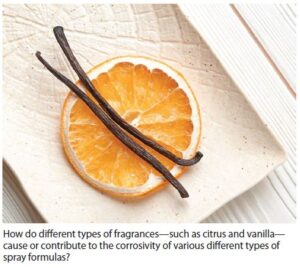Written on: January 1, 2024 by W. Stephen Tait
Happy New Year, everyone! In the August 2023 edition of Corrosion Corner, I discussed how corrosion failures are very expensive. These occur when packages leak, do not completely exhaust when spraying or when product is discolored or has a malodor because of package corrosion.
The cost of spray package corrosion could include:
• Corrosion testing
• Development of corrosion inhibitors
• Product recall when corrosion unexpectedly causes package or product failures
• Time and resources for investigating package failures
• Commercial or personal injury litigation
• Loss of sales
• Loss of both customer and consumer confidence in the products that failed from corrosion
Precise information on the corrosion costs to our industry is difficult to estimate. The global corrosion cost in 2022 was estimated to be $2.5 trillion, which is approximately 3.4% of the global gross domestic product (GDP) for that year. Clearly, corrosion is a major global concern to all industries, including the aerosol industry.
There are still many gaps in our knowledge about what causes spray package corrosion, as well as how to control and prevent it. These knowledge gaps in spray package corrosion lead to multiple questions that should be considered while developing a new spray product or derivative products for existing product lines.
My original perspective was published in the February 2014 edition of Corrosion Corner. That list still applies to spray packaging corrosion today and has since expanded, so an update is useful. The list of corrosion questions to consider during development of all spray products, changes to a formula’s ingredients, as well as changes in packaging and package materials includes:
1. How does the type of formula water cause or contribute to spray package corrosion?
2. Will an anhydrous formula be contaminated with water at some point in the manufacturing and filling process?
3. Is there a critical contaminant water concentration range for an anhydrous formula, above or below which the formula becomes corrosive?
4. How do the different types of fragrances (e.g., citrus, vanilla, etc.) cause or contribute to the corrosivity of various different types of spray formulas (e.g., aqueous, ethanol-water, emulsions, etc.)?
5. How and when do fragrances behave like corrosion inhibitors?
6. Which fragrance types exhibit the ability to inhibit spray package corrosion?

7. What initiates the various types of spray package corrosion, such as vapor phase, crevice and pitting corrosion?
8. What are the safe formulas—ones that will not cause or contribute to spray package corrosion?
9. Are there specific chemicals to avoid using in specific types of formulas?
10. What causes package corrosion to be random in its type—and its location—inside a package?
11. What are the best practices for spray package corrosion testing?
12. How should corrosion tests be designed to address:
a. Formula composition variability during manufacturing
b. Raw material variability
c. Variability of package materials?
This is quite a list! Reviewing it gives an appreciation for the breadth and depth of factors that influence whether or not spray package corrosion will occur with a given type of package/formula combination.
Hopefully this list also provides guidance on what areas of corrosion research need further development. Obviously, research produces more expedient and effective spray package corrosion control and prevention programs for companies using spray packaging for their products.
Thanks for your interest and I’ll see you in February. Contact me at 608-831-2076; rustdr@pairodocspro.com or from our two websites: pairodocspro.com and aristartec.com. SPRAY